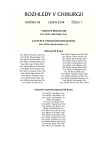Laparoscopic cholecystectomy in children and adolescents
Authors:
D. Starý; R. Macháček; R. Doušek; B. Hnilička; J. Tůma; L. Plánka
Authors‘ workplace:
Klinika dětské chirurgie, ortopedie a traumatologie, Fakultní nemocnice Brno
přednosta: Prof. MUDr. L. Plánka, PhD.
Published in:
Rozhl. Chir., 2014, roč. 93, č. 1, s. 11-15.
Category:
Original articles
Overview
Introduction:
In the treatment of cholelithiasis in adults, laparoscopic cholecystectomy is the method of first choice. There is plentiful literary evidence of the low complication incidence in this age group, but similar assessment is lacking in the paediatric population. In this work, the authors focus on cholelithiasis in children and the possible use of laparoscopy in the diagnostic – therapeutic scheme.
Material and methods:
The study group consisted of 148 patients operated on by laparoscopic cholecystectomy between 2002 and 2011 at the Department of Paediatric Surgery, Orthopaedics and Traumatology of University Hospital Brno. The first objective of the study was to evaluate the length of surgery; the second one was the occurrence of complications which were divided into intraoperative and postoperative. Intraoperative complications were subdivided into severe and moderate, postoperative complications into early and late. The last objective was to evaluate the benefit (number of complications, treatment outputs) of intraoperative cholangiography for obstructive jaundice before the surgery.
Results:
In the above mentioned period, 143 laparoscopic cholecystectomies and five laparoscopic cholecystectomies including splenectomy were performed. The average age of the patients was 13.9 years; the average length of laparoscopic surgery was 52 minutes. One major, serious intraoperative complication (0.7%) was recorded – injury to the ductus hepaticus communis. Moderate intraoperative complications occurred in 4.5%. Furthermore, one serious early postoperative complication (0.7%) – bleeding from the cystic artery -–and one minor (0.7%) – in a patient with acute pancreatitis after endoscopic retrograde cholangiopancreatography – was recorded. Late postoperative complications occurred in 4% of the patients. Conversion of laparoscopic operation with a definitive resolution of the serious condition was performed in one patient because of the aforementioned serious intraoperative complications. Eleven patients underwent intraoperative cholangiography; extraction of stones from the bile duct was performed in six cases.
Conclusion:
Intraoperative cholangiography in children and adolescents can be recommended as a safe and effective imaging modality for patients with preoperative evidence of biliary obstruction. Laparoscopic cholecystectomy in children and adolescents can be clearly recommended as an effective and safe surgical technique convenient for paediatric patients.
Key words:
laparoscopic cholecystectomy – choleolithiasis – child
Sources
1. Lengyel B, Azagury D, Varban O, et al. Laparoscopic cholecystectomy after a quarter century: why do we still convert? Surg. Endosc 2012;26:508–513.
2. Ryska M, Skála J. Laparoskopická cholecystektomie. Bulletin HPB chirurgie, 1993;1:5–6.
3. Ammori BJ, Davides D, Veyakis A, et al. Day-case laparoscopic cholecystectomy: a prospective evaluation of a 6-year experience. J. Hepatobiliary. Pancreat Surg 2003;10:303–308.
4. Loepke AW, Soriano SG. An assessment of the effects of general anesthetics on developing brain structure and neurocognitive function. Anesth Analg 2008;106:1681–707.
5. El-labban G, Hokkam E, Saber A, et al. Laparoscopic elective cholecystectomy with and without drain: A controlled randomised trial. J Minim Access Surg 2012;8:90–2.
6. Erhart D, Pohnán R. 55 laparoskopických cholecystektomií jednoincizním laparoskopickým přístupem – iniciální zkušenosti. Rozhl Chir 2011;90:361–364.
7. Khan N, Naeem M, Bangash A, et al. Laparoscopic cholecystectomy: An Experience at Lady. J Ayub Med Coll Abbottabad 2010;22:46–51.
8. Torney MVU, Dell-Kuster S, Mechera R, et al. The cost of surgical training: analysis of operative time for laparoscopic cholecystectomy. Surg Endosc and other interventional techniques 2012;26:2579–2586.
9. Šafránek J, Šebor Jr. J, Geiger J. Konverze laparoskopické cholecystektomie. Rozhl Chir 2002;81:28–31.
10. Ausania F, Holmes LR, Iype S, et al. Intraoperative cholangiography in the laparoscopic cholecystectomy era: why are we still debating? Surg Endosc 2012;26:1193–1200.
11. Flum DR, Koepsell T, Heagerty P, et al. Common bile duct injury during laparoscopic cholecystectomy and the use of intraoperative cholangiography: averse outcome or preventable error? Arch Surg 2001;136:1287–1292.
12. Jurka M, Prášek J, Czudek S, et al. Zpráva o 3061 laparoskopických cholecystektomiích. Rozhl Chir 1994;73:160–164.
13. Waage A, Nilsson, M. Iatrogenic bile duct injury: a population-based study of 152 776 cholecystectomies in the Swedish Inpatient Registry. Arch Surg 2006;141:1207–1213.
14. Freeman ML, DiSiario JA, Nelson DB, et al. Risk factors for post-ERCPpancreatitis: A prospective, multicenter study. Gastrointest Endosc 2001;54:425–434.
15. Z‘graggen K, Aronsky D, Maurer CA, et al. Acute postoperative pancreatitis after laparoscopic cholecystectomy. Results of the Prospective Swiss Association of Laparoscopic and Thoracoscopic Surgery Study Arch Surg 1997;132:1026–30; discussion 1031.
16. Ford JA, Snoop M, Du J, et al. Systematic review of intraoperative cholangiography in cholecystectomy. Br J Surg 2012;99: 160–167.
17. Podnos YD, Gelfand DV, Dulkanchainun TS, et al. Is intraoperative cholangiography during laparoscopic cholecystectomy cost effective? Am J Surg 2001;182:663–669.
18. Emami CN, Garrett D, Anselmo D, et al. Single-incision laparoscopic cholecystectomy in children: a feasible alternative to the standard laparoscopic approach. J of Ped Surg 2011;46: 1909–1912.
19. Chandler NCH, Danielson PD. Single-incision laparoscopic cholecystectomy in children: a retrospective comparison with traditional laparoscopic cholecystectomy. J of Ped Surg 2011;46: 1695–1699.
Labels
Surgery Orthopaedics Trauma surgeryArticle was published in
Perspectives in Surgery

2014 Issue 1
Most read in this issue
- Urine derivation after radical cystectomy
- Pelvic exenteration in the treatment of advanced tumours of the small pelvis
-
Is thyroid and parathyroid surgery safe?
Is it suitable for one-day surgery? - Biliary stent as a cause of bowel obstruction
